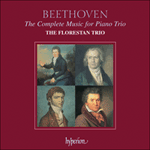
Welcome to Hyperion Records, a British classical label devoted to presenting high-quality recordings of music of all styles and from all periods from the twelfth century to the twenty-first.
Hyperion offers both CDs, and downloads in a number of formats. The site is also available in several languages.
Please use the dropdown buttons to set your preferred options, or use the checkbox to accept the defaults.

The middle movement is also in E flat, making this a rare Beethoven work that retains the same key and mode throughout. Though labelled ‘Scherzo’, this is really a minuet, gentler and more decorous than the examples Haydn was producing by this time. The delightful Trio is a bucolic German dance. For the finale Beethoven writes an easy-going rondo whose lilting theme is varied on each of its reappearances. The cello has more independence here than in the earlier movements, especially in the imitative dialogues in the second, ‘developing’ episode. The quiet sideslip to a surprise key in the coda is an early example of a Haydnesque gambit which Beethoven would fruitfully exploit in the years to come.
from notes by Richard Wigmore © 2004
Le mouvement médian ne dérogeant pas au mi bémol, cette œuvre est l’une des rares de Beethoven à constamment conserver la même tonalité et le même mode. Quoique étiqueté «Scherzo», il s’agit en réalité d’un menuet, plus doux et bienséant que ceux produits par Haydn à la même époque. Ce ravissant Trio est une bucolique danse allemande. Pour le finale, Beethoven écrit un rondo décontracté, dont le thème harmonieux est varié à chaque apparition. Le violoncelle y apparaît plus indépendant que dans les mouvements antérieurs, notamment dans les dialogues imitatifs du second épisode «en développement». La paisible glissade vers une tonalité surprise, dans la coda, est un exemple précoce d’une astuce haydnesque que Beethoven allait exploiter avec bonheur dans les années à venir.
extrait des notes rédigées par Richard Wigmore © 2004
Français: Hypérion
Der Mittelsatz steht ebenfalls in Es-Dur, was dieses Werk zu einem jener seltenen in Beethovens Schaffen macht, die durchweg die gleiche Tonart und den gleichen Modus beibehalten. Obwohl er als Scherzo bezeichnet wird, handelt es sich bei dem Satz in Wahrheit um ein Menuett, sanfter und schicklicher als die von Haydn um diese Zeit geschaffenen. Das wunderbare Trio ist ein bukolischer deutscher Tanz. Als Finale setzt Beethoven ein unbekümmertes Rondo, dessen beschwingtes Thema bei jedem neuerlichen Erklingen abgewandelt wird. Dem Cello wird hier mehr Unabhängigkeit zugestanden als in den vorhergehenden Sätzen, insbesondere in den imitativen Dialogen der zweiten, „durchführenden“ Episode. Das unauffällige Abgleiten in eine unvermutete Tonart in der Coda ist ein frühes Beispiel für einen an Haydn orientierten Kniff, den Beethoven in kommenden Jahren nutzbringend zum Einsatz bringen sollte.
aus dem Begleittext von Richard Wigmore © 2004
Deutsch: Anne Steeb/Bernd Müller
 Beethoven: The Complete Music for Piano Trio Beethoven: The Complete Music for Piano TrioEach instalment of The Florestan Trio’s Beethoven Piano Trio cycle was rapturously received. Now reissued as a special-price box-set, this superb series of benchmark recordings should not be missed.» More |

